La Loche: A small town’s grief. A nation’s shame.
How La Loche happened and what it says about Canada’s shocking neglect of First Nations in the North
Share

Before anybody could notice, the troubled teen took his grandfather’s shotgun and aimed. Consumed by a maelstrom of emotions, he slid his finger over the trigger, ready to kill. La Loche, Sask., was on the brink of discovering its next exposure to violent death, in a remote northwest village where snapshots of the too-young and gone are pushpinned to many household walls.
In this case, Cory Herman aimed a hunting gun to the head—his own. He was 19 years old, and had attempted to kill himself so many times before, by hanging or with pills, that he lost count past a dozen. Before Herman could let fly the shotgun pellets and sorrow, he heard his phone ring. It was Corrine, his younger sister. Their grandmother had noticed the shotgun was missing, Corrine said through tears. She loved him. She wanted him to see his first nephew, who she would deliver within months. “Please don’t try anymore. Be an uncle,” she told him. “That was the last time I tried,” Herman says.
Herman, now a 22-year-old uncle, helped organize a gathering last weekend to mark the actions of an individual who followed through with a shotgun and dark intentions. Two teen brothers were left dead at their home on the village’s Dene Crescent, while at La Loche Community High School two staff were killed, and gunshot wounds were inflicted on seven others, including students. A 17-year-old boy who cannot be named under the Youth Criminal Justice Act was arrested and charged with four counts of first-degree murder in one of the worst school shootings in Canadian history.

Even in a community isolated at the northern end of Highway 155, with so little economic opportunity and such unhealthy familiarity with addictions and violent attacks, this was an unprecedented and unimaginable scale of destruction. It has brought the attention of the national and international media, visits from the Saskatchewan premier and on Friday the Prime Minister is scheduled to visit, along with likely a flurry of policy ideas and pledges for action. “A lot of people say in our community the only time we see politicians are two times: once for election, and once for a crisis. So it’s a four-year cycle, or in our case, interventions between those cycles,” says Leonard Montgrand, executive director of the La Loche Friendship Centre.
These gestures and considerations had been absent as a much higher death toll was slowly building in this town: suicides, predominantly among the young who have lost hope. Last year in La Loche, seven people took their lives. For a town of roughly 2,600 people, that amounts to about 269 per 100,000—more than 20 times the provincial average.
To be fair, last week’s quadruple homicide was not a clear symptom of La Loche’s struggles, and many residents don’t see it that way either. The notoriously quiet suspect had reportedly lashed out about bullying and teasing for his large ears. But this tragedy risks inflicting symptoms of its own on La Loche: more suicide, alcohol, addiction, depression, perhaps more violence, a step back after repeated attempts to improve the town’s outlook. The village’s provincial liquor store was ordered shut the day after the multiple shootings and remained closed the following week (as did the high school), in one of the first attempts to staunch further bleeding.
Cory Herman’s suicide prevention group drew about 250 to its largest public gathering yet, on Sunday after the slayings. The group is proud to report there hasn’t been one suicide since last October. It’s been encouraging, but they’re not sure they can maintain this streak as fresh grief blankets this close community.
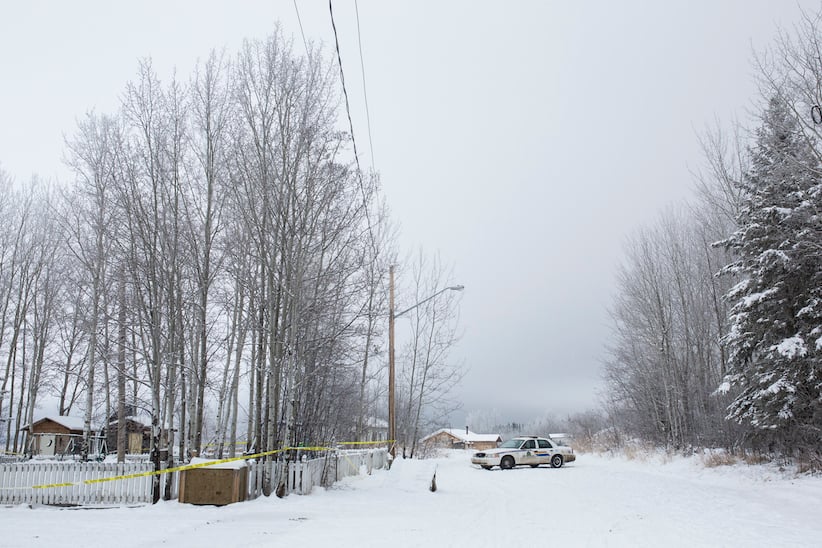
La Loche, a village that neighbours Clearwater River Dene Nation, is a seven-hour drive from Saskatoon. The first European portager arrived on the shores of Lac La Loche in 1778; a fur trading post followed a decade later. Then came the Catholic church, residential school program, liquor store and the slow disintegration of the hunting and trapping economy, along with its replacement by a wage-based economy with far too few employers to provide those wages. Northern uranium mines offer some employment, including to Alicia Fontaine, mother of the two slain teen boys. (She was headed to work after she dropped them off at school that Friday morning, for what would be the last time.)
But with a 26.4 per cent unemployment rate that nearly matches its employment rate, the majority of cheques in La Loche are government assistance. The nearest bank is 100 km south in the town of Buffalo Narrows, so rather than deposit and save, locals cash cheques for a fee of $30 for every $1,000 at the gas station or other stores. With little else to occupy their time, many spend their funds on booze, pot, crack or other illicit comforts. “The only bank that we have is the lakeshore’s bank,” quipped Andrew Lemaigre, 65, pointing to the water. A lack of job opportunities has dogged the village since his youth, he says.
Pedestrians number fewer than roaming dogs along the sides of La Loche roads, as people zip by in pickup trucks, snowmobiles and ATVs. In addition to lacking a bank, there are no hotels or sitdown restaurants—which Buffalo Narrows does boast, despite having less than half La Loche’s population. There’s a Tim Hortons counter in Buffalo Narows, and a Subway sandwich shop is coming soon.
People are afraid to invest here, says Montgrand. There’s a “stigma of La Loche being a community that’s something out of the Wild West, which isn’t true. Our community has a handful of problems. I mean, what do you expect?”
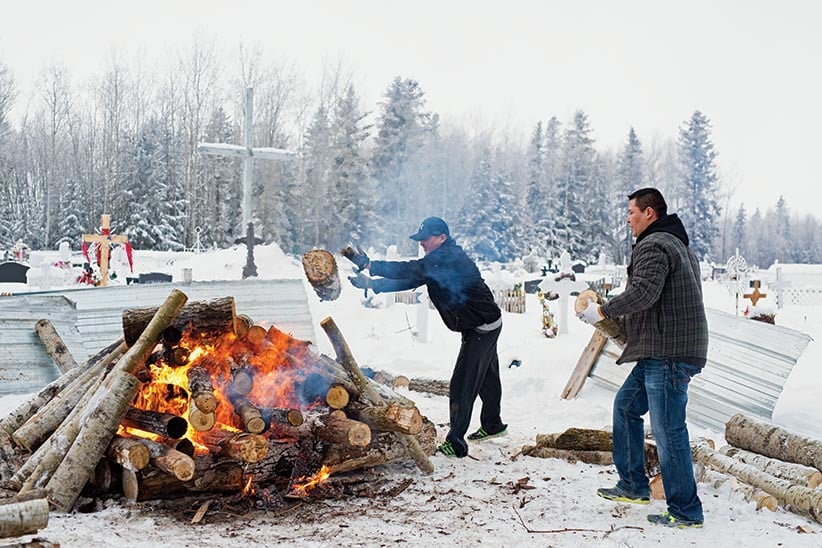
To many in Saskatchewan, La Loche is synonymous with violence. Beer bottles have been prohibited since 2002, a year after more than two dozen glass attacks were reported. In 2011, a mob of house partiers burned an RCMP truck and damaged an ambulance and the health centre after they suspected police made an ATVer crash into a ditch; another violent break-in at the hospital happened two years ago. One teen was arrested for stabbing another at the high school in 2011. Gang violence was a problem, culminating in the fatal shot to the head of Matthew St. Pierre on a weekend afternoon in 2010, right across the street from the RCMP detachment, Montgrand said. He points to St. Pierre’s picture on his bulletin board; it’s his nephew. “That shook up a lot of people. Made the younger people realize: it’s not a game,” Montgrand said. La Loche’s gang problem faded after that, he added, perhaps a signal this community is capable of turning a corner after this tragedy, too.
About 48 hours after the Friday afternoon murders, acting mayor Kevin Janvier publicly called for the pellet-scarred high school to be demolished and rebuilt, to erase physical memory of the trauma. This is what happened in Connecticut, after a gunman killed 26 children and adults at Sandy Hook Elementary School.
La Loche’s darkest moments began on Jan. 22 around the lunch break at a house near the school that locals call Dene High. Drayden Fontaine, 13, and Dayne Fontaine, 17, were both found dead at their house. Some friends received a disturbing group message through social media: “Just killed 2 ppl. Bout to shoot ip the school.”
A three-minute drive from that house, shooting began around 1 p.m., first in the main entrance, where a large hole blasted through the front door’s glass. The gunman continued shooting for about eight minutes. By then he had killed two more: Marie Janvier, a 21-year-old teacher’s aide from the village, and Adam Wood, a 35-year-old from Uxbridge, Ont., who had begun his teaching career in La Loche four months ago. The police arrested the suspect at gunpoint. Seven more were shot but survived, including a teacher’s aide shot in the face, sources say. A student whose arm was badly wounded was ferried the short distance toward the hospital, but the vehicle hit a ditch en route and the boy jumped out and ran the rest of the way, sources told Maclean’s.
Unlike in the nearest southern hospital, doctors here all fly in from elsewhere for two-week stints; there are normally three or sometimes two on hand on a Friday. Some good fortune: “If there weren’t four doctors here, it would have been a disaster,” says one health system source, who is not authorized to speak on the record. They were unable to revive one person brought in with no vital signs. Doctors and staff stabilized the other seven patients before they were flown to Saskatoon.
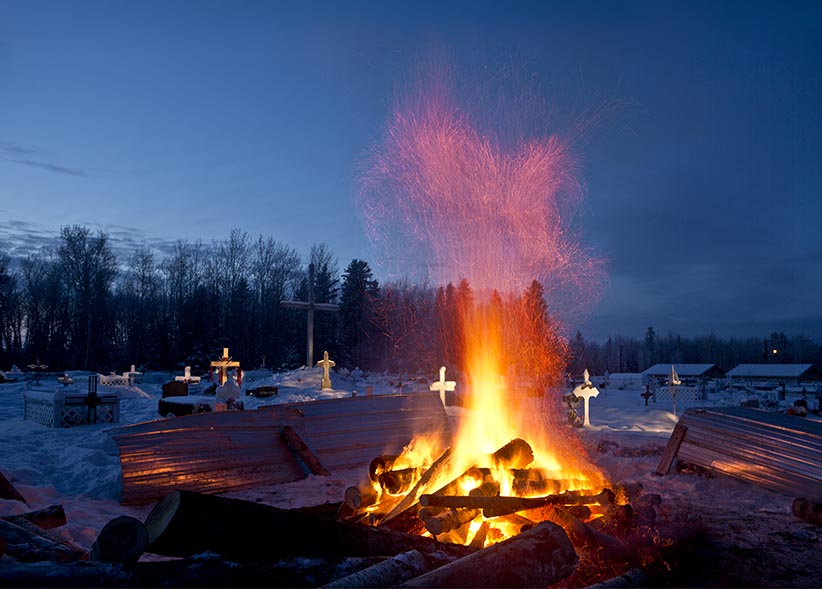
Word quickly ricocheted around La Loche about who was shot and arrested. Then word spread to Canadian media and Prime Minister Justin Trudeau, who announced the mistaken figure of five deceased while at a conference in Davos, Switzerland. Commenting on a Facebook picture of the three slain La Loche residents, Alicia Fontaine wrote: “My heart shattered into a million pieces so sad I don’t have no more babies.”
After that night’s impromptu candlelight vigil, a small memorial began forming outside the school’s police tape: teddy bears, roses, votives and balloons. An Alberta couple visiting nearby left cigarettes as a tobacco offering; Cody Montgrand, 30, brought from his nightstand a Virgin Mary figurine that belonged to his late grandfather; Premier Brad Wall left flowers; and the deceased boys’ mother visited silently Sunday afternoon, a small crowd gathered close to support her.
By then, a large log fire had been set at the La Loche cemetery, above the site where Marie Janvier was to be buried. The next day, volunteers started another fire, bracketed by corrugated sheet metal, at the double plot set aside for Alicia Fontaine’s sons. It’s a ritual, but a practical one rather than spiritual: to thaw the ground for gravediggers’ shovels. The fathers of the slain boys came to help start the fire with gasoline; Gerald Moise, dad to Dayne, conceded he wasn’t close to the boy. “Sometimes [we] just pass by vehicles. He smiles back at me.” He has two younger kids, and said he’s trying to stay strong for them.
Amid hymns sang in Dene by the standing-room only crowd at Catholic mass on Sunday, Murray Chatlain, the region’s Manitoba-based archbishop, relayed a prayer intention from the Fontaine boys’ grandparents: to pray for the deceased, and not be angry at the suspected assailant. “Anger is a very normal response in this. But what we do with that anger is very important,” Chatlain explained later to reporters. There were many tears, but few signs of anger among residents in the days immediately afterwards.
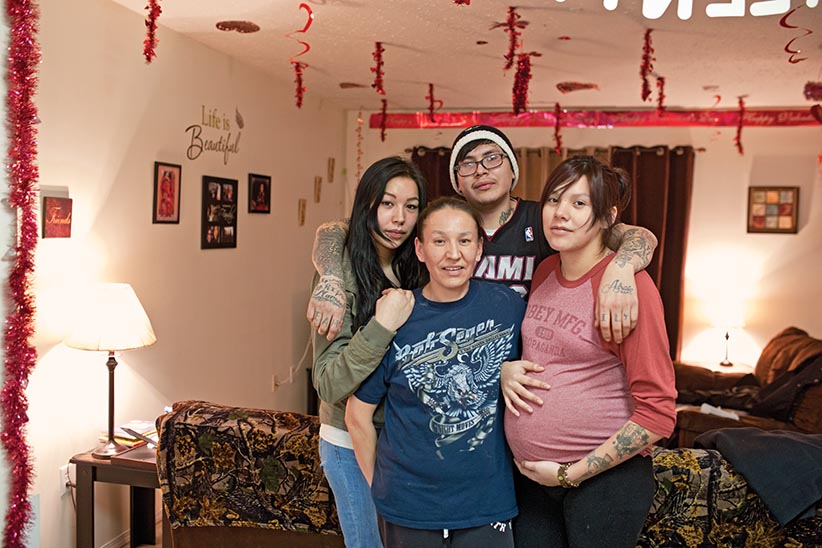
At the anti-suicide group’s gathering Sunday evening, some held thin candles, enjoyed hot supper, or lined up for the archbishop’s benedictions. Herman started this group on Facebook last fall, after one uncle killed himself in September, then another one followed out of grief. Friends joined the group, and it moved beyond social media to offer informal counselling at these bi-weekly meetings, an informal grassroots accompaniment to various government-funded initiatives that had sprung up before 2015’s stunning suicide toll.
Some of Cory Herman’s friends spoke out at the meeting, including Perry Herman, who said he’s been teased and bullied just like the arrested suspect had been. “If he had turned around and just killed himself, how would your reactions to the situation be right now?” he asked the crowd. After his plea for action and for anybody troubled to reach out for help rather than exploding, another lineup formed: to hug Herman.
Musicians played inspirational country songs. Many attendees sang along to Missing You, by an Alberta Cree named Len Laboucan: “I didn’t have time to tell you you meant so much to me / Oh, how much I miss you so / But now you’re gone to a home far away.”
For people in La Loche, it’s a lyric sung for many loved ones.
The whole of northern Saskatchewan is serviced by just one psychiatrist. Based in Ottawa, Elena Shurshilova flies in every two or three months for a week, paying many of her own expenses. She took on the practice in 2013, when she was doing her medical residency at the University of Saskatchewan, and has kept it up after moving to Ontario, as there is no one to take her place. “I get paid 50 per cent of what people get paid in a nice, clean warm office in Saskatoon,” she told the Star-Phoenix last spring. “It takes somebody with no sense to fly there for this amount of money.”
Aboriginal leaders are quick to point out that La Loche is not alone in its problems and risks. High suicide and addiction rates dovetail with low employment opportunities and infrastructure shortages throughout many of Canada’s towns and reserves. “We certainly haven’t been paying enough attention. These are problems in central and southern Saskatchewan, too,” said Chief Bobby Cameron of the Federation of Saskatchewan Indian Nations. “The pleas for help have been ongoing for decades. It’s just finally come to a head.”
Of course, depression and self-harm aren’t just problems in Saskatchewan either. Nunavut experienced 45 suicides in 2014, a rate that given its small population was 13.5 times the national average, and among teenage boys, was 40 times higher than in the rest of the country. The territory’s fed-up chief coroner convened a public inquest into the problem last year, and in September a jury agreed with her recommendation that suicide be declared a public health emergency in the Far North. The government of Nunavut stopped just short, terming it a “crisis,” but has formed a special cabinet committee to implement the inquest’s 41 findings, including changes to the Mental Health Act, school programs and mandatory training for RCMP and health care workers who come from away.
An almost unbreakable cycle of poverty, neglect and indifference has plagued remote communities across the North for decades.In the 1990s, the Innu hamlet of Davis Inlet in Labrador became an international emblem of Canada’s shame with its twin epidemics of suicide and gas sniffing. Established as a permanent community in 1967 at the behest of the government and missionaries, the tiny island village was isolated, overcrowded and lacked even the most basic water and sewage systems. Addiction was rampant, with more than 50 alcohol-related deaths between 1973 and 1995, in a population of fewer than 500. After a 1992 house fire killed six children, grief took over with more than a quarter of Davis Inlet youth attempting suicide, and solvent abuse skyrocketed with kids as young as five. The problems have persisted, even after the community was relocated to the mainland in 2002.
Gregory Rich, the chief in the new community of Natuashish, says progress is being made, but that it can be fitful. “We have flare-ups once in a while with gas sniffing,” he told Maclean’s. “But it used to be 30 or 40 kids in the streets doing it, and now it’s just six or seven.” Living conditions have vastly improved, and there have been significant investments in infrastructure for youth like the new arena and recreation facility in Natuashish, as well as an expanded treatment centre. The suicide rate has dropped, and drinking has diminished, with almost half the population now taking part in the healing process.
The building spree and upkeep costs, however, helped plunge the band deep into debt, and forced the federal government to step in nd clean up its finances. “The bills are still there, but we’re developing a plan to deal with them and get out of co-management,” says Chief Rich. There have been talks about launching a new eco-tourism venture. He is optimistic for the future. “It’s a daily battle, but it’s getting easier,” says the chief.
When Saskatchewan’s premier visited La Loche in the tragedy’s wake he insisted there’s much being done to support the village, and said more perhaps should be done for health, education and social services, but it was too soon for specifics. “I was told the X-ray machine was working [on Friday], thank God. Working well, but that’s not always the case,” Brad Wall said Sunday. Clement Chartier of the Metis National Council, whose son is the Clearwater Dene chief and whose granddaughter was at the school during the shooting, expressed hope Justin Trudeau’s “sunny ways” would bring infrastructure and services for communities like La Loche.
“We need to have hope for the young people, and part of that is getting access to jobs where they are,” Chartier said.
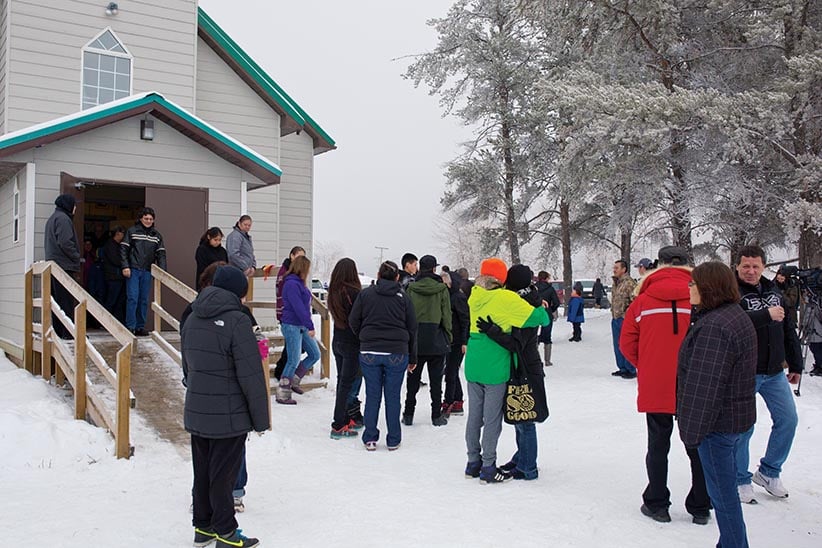
Fort McMurray is a short crow’s fly over the Saskatchewan–Alberta border, but aside from an iffy winter road there’s no connection to the oil sands capital that employed many La Loche-area residents before oil prices collapsed. In 2005, then-premiers Ralph Klein and Saskatchewan’s Lorne Calvert announced that winter road would become an all-season highway by 2008. “Road to riches,” declared a front-page headline in Saskatoon. The road was never completed on the Alberta side — the government focused on improving the deadly Edmonton–Fort McMurray highway —and it isn’t on any provincial timetable.
La Loche also shares some of the same gooey riches as Fort McMurray, but that potential too awaits some follow-through. Geologists with a junior exploration firm named Oilsands Quest estimated reserves at eight billion barrels, and set up an office on La Loche’s main street. But Quest’s ambition dissolved with its 2012 bankruptcy declaration—Cenovus picked up the Sasktachewan claims, but there are no development plans.
Cory Herman, now unemployed, hopes to one day work in Alberta, or as a construction worker or carpenter where work’s available. He has that option because he couldn’t follow through with his own plans to wield a shotgun. His arms and torso are covered with tattoos that explain why he’s staying alive: names of his sisters and their kids. He’ll have to find room soon to ink the name of Corrine’s second son: he’s due to arrive in late February. Corrine, too, had attempted suicide a year ago, saddened by a breakup. Cory found her in the bathroom, blacked out and hanging by a wire around her neck. “It would have meant this family would have been broken,” she said, as she brought two fists together then splayed them outward.
Many locals fret their northern village is broken after that recent afternoon of gunfire and terror; the mayor said the community is “shattered.” They get upset if media or others call them hopeless. Say they’re without hope, as a headline in the aftermath did, and they worry it suggests there’s nothing for them to live for. They know the problems are as severe or worse than other remote populations, but they keep reaching for reasons to push for improvement, for a turnaround. The sources of joy or hope vary. Hunting, quadding and summer fishing are a delight for many. For Cory Herman, he’s excited to be an uncle once again. For his sister Corrine, hope lays inside her swollen belly, and in her other dreams for tomorrow. She wants to become a cook or carpenter. Probably not in La Loche—in Saskatoon, maybe.
In the coming weeks, Herman worries his suicide prevention group will have its hands full, with upcoming wakes and funerals for the fallen, and as a deep sorrow lingers. For La Loche, as in other suicide-plagued communities politicians haven’t visited, tragedy compounds atop tragedy. “All the suicide has brought a lot of people down, straight to the ground, and they lost faith, hope, trust, respect and loyalty,” Cory Herman says. “And that’s what we’re trying to do: help them fix each other.”
—with Jonathon Gatehouse